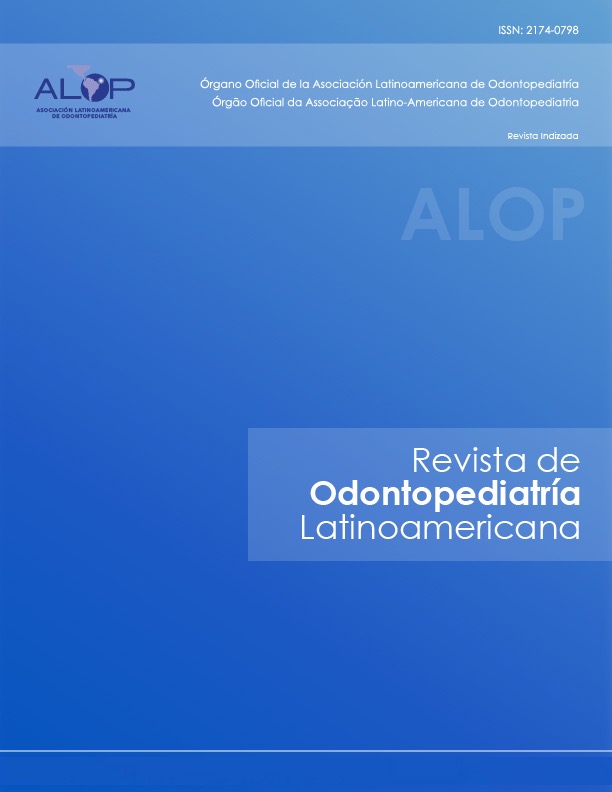Oral health related quality of life, socioeconomic and behavioral characteristics in children under 7-years old with cleft lip and palate
DOI:
https://doi.org/10.47990/alop.v8i1.143Keywords:
Child, Quality of life, Oral health, Cleft lipAbstract
Introduction: Cleft lip and/or cleft palate is a congenital malformation in the lip region and/or palate, caused by the lack of closure in such structures. Severity can vary and affect the habits and the oral health related quality of life in this patients. Objective: The objective of this study is to evaluate the quality of life in relation to oral health and socio-behavioral characteristics of patients under 7-years old with cleft lip and palate. Materials and Methods: After the approval of the ethics committee, the study was conducted at a clinic for patients with cleft lip and/or palate. A convenience sample consisted of 19 patients whose caregivers agreed to participate and answer the requested questionnaires. The Early Childhood Oral Health Impact Scale questionnaire was applied to measure the quality of life in relation to oral health. Socioeconomic variables were collected through a specific questionnaire used in previously studies, as well as questions about fear and care for oral hygiene of children. Data were analyzed descriptively. Results: Most patients belonged to the male and the average age was 3.9 years. Most caregivers reported difficulty and fear to perform oral hygiene of children and difficulty to feed them. Regarding the quality of life, a greater impact on the child than in the family was found. Conclusion: It can be concluded that patients younger than 7 years of age with clefts lip and palate may have difficulty in cleaning and feeding as well as changes in oral health related quality of life.
References
Mossey Pa, Castillia E. Global Registry And Database On Craniofacial Anomalies. Geneva: World Health Organization; 2003.
Al Omari F, Al-Omari Ik. Cleft Lip And Palate In Jordan: Birth Prevalence Rate. Cleft Palate Craniofac J. 2004; 41(6): 609–12.
Clarren Sk, Anderson B, Wolf Ls. Feeding Infants With Cleft Lip, Cleft Palate Or Cleft Lip And Palate. Cleft Palate J 1987; 24(3): 244-9.
Kramer Fj, Gruber R, Fialka F, Sinikovic B, Schliephake H. Quality Of Life And Family Functioning In Children With Nonsyndromic Orofacial Clefts At Preschool Ages. J Craniofac Surg. 2008; 19: 580-587.
Munz Sm, Edwards Sp, Inglehart Mr. Oral Health-Related Quality Of Life, And Satisfaction With Treatment And Treatment Outcomes Of Adolescents/Young Adults With Cleft Lip/Palate: An Exploration. Int J Oral Maxillofac Surg. 2011; 40: 790-796.
Hunt, O., D. Burden , P. Hepper , Et Al. The Psychological Effects Of Cleft Lip And Palate: A Systematic Review. Eur J Orthod 2005. 27: 274–285.
Who (2003). The World Oral Health Report 2003: Continuous Improvement Of Oral Health In The 21st Century—The Approach Of The Who Global Oral Health Programme. Geneva, Switzerland: World Health Organization [Pubmed]
Piovesan C, Antunes Jl, Guedes Rs, Ardenghi Tm. Impact Ofsocioeconomic And Clinical Factors On Child Oral Health-Relatedquality Of Life (Cohrqol).Qual Life Res. 2010; 19: 1359-66.
Antunes Ls, Maues Cpr, Nadaes Mr, Costa Mc, Kuchler Ec, Antunes Laa. The Impact Of Nonsyndromic Oral Cleftson Family Quality Of Life . Spec Care Dentist. 2014; 34(3): 138-43.
Bos A, Prahl C. Oral Health-Related Quality Of Life In Dutch Children With Cleft Lip And/Or Palate. Angle Orthod. 2011.
Klassen Af, Tsangaris E, Forrest Cr, Wong Kw, Pusic Al, Cano Sj, Syed I, Dua M, Kainth S, Johnson J, Goodacre T. Quality Of Life Of Children Treated For Cleft Lip And/Or Palate: A Systematic Review. J Plastreconstraesthetsurg 2012; 65: 547-57.
Tesch, FC; Oliveira, BH; Leão, A. {Semantic equivalence of the Brazilian version of the Early Childhood Oral Health Impact Scale}. Cad Saude Publica 2008; 24: 1897-909.
Agostini BA, Pinto LT, Koehler M, Emmanuelli B, Piovesan C, Ardenghi TM.Trend of traumatic crown injuries and associated factors in preschool children. Braz Oral Res. 2016 Oct 10; 30(1): e112. doi: 10.1590/1807-3107BOR-2016. vol30.0112.
Paul T, Brandt R. Oral And Dental Health Status Of Children With Cleft Lip And/Or Palate. Cleft Palate Craniofac J. 1998; 35: 329-32.
Antonarakis, G. S., P-K. Palaska, and Georges Herzog. Caries prevalence in non-syndromic patients with cleft lip and/or palate: a meta-analysis. Caries research. 2013; 47.(5): 406-13.
Moua Am, Andre M, Faraj J, Dias Rb. Avaliação De Bebês Portadores De Fissura Labiopalatina Em Relação Á Higiene Oral. Rev. Odonto. 2009; 17(34): 64-9.
Mastrantonio Sds, Castilho Arf, Carrara Cfc. Anomalias Dentárias Em Crianças Com Fissura De Lábio E Palato. Odontol.Clín. Cient. 2009; 8: 273-278.
Neves Acc, Patrocínio Mc, Lemek P, & Ui R T. Anomalias Dentárias Em Pacientes Portadores De Fissuras Labiopalatinas: Revisão De Literatura. Revista Biociências 2008; 8(2).
Vallino Ld , Zuker R , Napoli Ja. A Study Of Speech, Language, Hearing, And Dentition In Children With Cleft Lip Only. Cleft Palate–Craniofacial Journal. 2008; 45(5).
Topolski Td, Edwards Tc, Patrick Dl. Quality Of Life: How Do Adolescents With Facial Differences Compare With Other Adolescents? Cleft Palate Craniofac J. 2005; 42: 25-32.
Downloads
Published
Issue
Section
License
Copyright (c) 2018 Latin American Pediatric Dentistry Journal

This work is licensed under a Creative Commons Attribution-NonCommercial-ShareAlike 4.0 International License.























